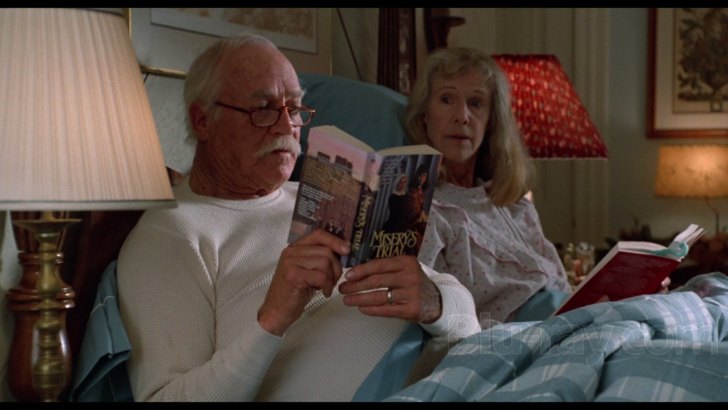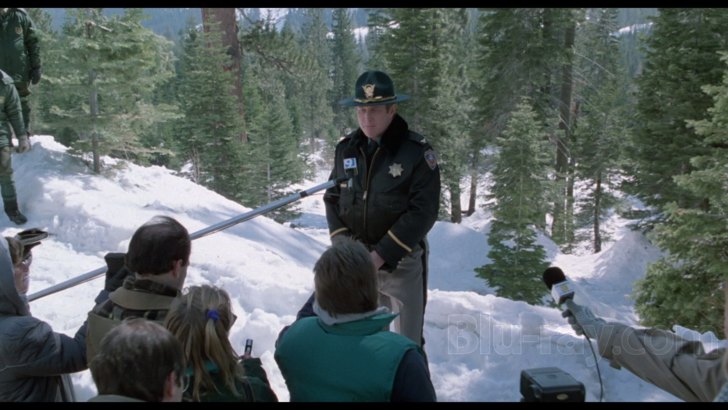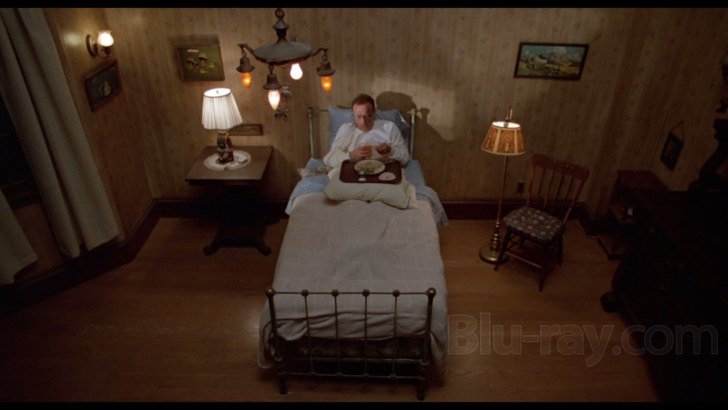Misery Blu-ray Movie
HomeMisery Blu-ray Movie 
Remastered | Collector's EditionShout Factory | 1990 | 107 min | Rated R | Nov 28, 2017

Movie rating
8 | / 10 |
Blu-ray rating
| Users | 4.8 | |
| Reviewer | 4.0 | |
| Overall | 4.0 |
Overview
Misery (1990)
A successful romance novelist, after being disabled in a car crash, is held captive by a psychotic fan.
Starring: James Caan, Kathy Bates, Richard Farnsworth, Frances Sternhagen, Lauren BacallDirector: Rob Reiner
| Horror | Uncertain |
| Psychological thriller | Uncertain |
| Thriller | Uncertain |
| Drama | Uncertain |
Specifications
Video
Video codec: MPEG-4 AVC
Video resolution: 1080p
Aspect ratio: 1.85:1
Original aspect ratio: 1.85:1
Audio
English: DTS-HD Master Audio 5.1 (48kHz, 24-bit)
English: DTS-HD Master Audio 2.0 (48kHz, 24-bit)
Subtitles
English SDH
Discs
Blu-ray Disc
Single disc (1 BD)
Packaging
Slipcover in original pressing
Playback
Region A (locked)
Review
Rating summary
| Movie | 4.5 | |
| Video | 4.0 | |
| Audio | 4.0 | |
| Extras | 4.0 | |
| Overall | 4.0 |
Misery Blu-ray Movie Review
Second Release of MISERY on BD
Reviewed by Dr. Stephen Larson December 12, 2017At an airport bookstore one day in 1990, producer Andrew Scheinman spotted a hardcover of Stephen King's 1987 novel Misery, which he bought under the assumption that his friend and collaborator, Rob Reiner, may want to adapt it into a movie. But Reiner was skeptical that Misery hadn't already been optioned by one of the Hollywood majors. To his great surprise and delight, no studio had purchased the rights to it. Misery was a very important and deeply personal book to King, who was leery of the potential harm filmmakers may inflict when cinematizing it. King had liked Reiner's Stand by Me and the two had an agreeable phone conversation, with King indicating he would sell the novel (for a lot of money). Reiner would produce it under the aegis of his production company Castle Rock Entertainment but would find someone else to direct.
According to Misery adapter William Goldman in one of his screenwriting volumes, George Roy Hill was the first choice to direct. Hill initially agreed but when he read the script's version of King's "lopping scene," he couldn't sleep all night. It entails psychiatric nurse Annie Wilkes sawing off the feet of her favorite author as punishment for his attempts to flee his room. That scene convinced Goldman to write the screenplay while he was still reading the book. However, Hill couldn't picture himself ever directing Annie's maiming of Paul Sheldon so he reneged. When Goldman was about to send his script to Barry Levinson, Reiner stepped in and vowed that he would direct Misery himself. Reiner first had no qualms about directing the lopping scene but sought opinion from others at Castle Rock who read the script. Reiner recounted to Goldman that three secretaries told him to leave the scene alone. Warren Beatty, who was interested in playing Paul, read Goldman's treatment and thought the lopping would render the already-injured author a loser. While Goldman went on vacation before principal photography began, Reiner, Scheinman, and Beatty made some revisions to the script to make it tighter and more taut. Upon his return, Goldman was furious at the changes (including the major scene in question). Lopping had been replaced with hobbling so Paul was a more active protagonist rather than a permanent cripple. Had Annie sliced Paul's feet off, Reiner felt that he would have lost the audience completely. When Goldman saw a cut of the film at a cast/crew screening, he discovered that he was wrong as the new scene more than served its purpose without going over the top.
When offered to play the mostly bedridden role of Paul Sheldon, nearly every major Hollywood actor passed. As Reiner and Goldman have recalled, William Hurt, Kevin Kline, Michael Douglas, Harrison Ford, Dustin Hoffman, Robert DeNiro, Al Pacino, and Robert Redford all declined. Richard Dreyfus had a preliminary agreement with Reiner but that came before he read the script. Beatty remained interested but he had too many responsibilities to juggle on Dick Tracy. Scheinman suggested James Caan and Misery ended up being a comeback for the Bronx native after he sporadically took acting roles throughout the eighties. The equally important role of Annie Wilkes was much more straightforward. Goldman penned his screenplay with Kathy Bates in mind having seen her perform in several plays. Reiner had also watched Bates on Broadway and agreed that the part should be portrayed by someone relatively unknown on the silver screen. Bates delivers a precise and pitch-perfect interpretation of the hyper-obsessed fan, rightfully garnering the Golden Globe and Oscar for best lead performance.

Paul Sheldon's number one fan introduces her patient to Misery the Pig.
While Misery is predominately a two-character psychological drama in an enclosed space, it benefits from secondary characters who were not originally in the novel but serve an important function in the Goldman/Reiner narrative. Richard Farnsworth gives the audience a reprieve from the confines of Mrs. Wilkes's secluded home in the Rockies. Playing a benignant sheriff named Buster, Farnsworth has the third most time on screen. When he learns from literary agent Marcia Sindell (Lauren Bacall) that her client has gone missing, Buster begins a long search for Sheldon. He then learns from hotel manager Libby (Graham Jarvis) that the popular author indeed departed the Silver Creek Lodge in a big storm. Buster's wife, Virginia (Frances Sternhagen), is also his deputy and there is a humorous sexual tension when she puts her hand on her husband's lap while driving around. When Paul's '65 Mustang is found, Buster is skeptical that the Misery author is really dead and does his own detective work. One anticipates that he will eventually catch up to what Annie is up to and that adds another layer of tension.
After post-production wrapped on Misery, King was invited to a private screening in LA. Apparently he didn't raise any serious objections to the filmmakers altering Annie's horrific act or any of the abridgments made to his book. Reiner told Sean Mitchell of the Los Angeles Times that after the movie was over, King approached the director and gave him "a big hug." Mitchell recorded that of the seventeen film and television adaptations produced from King's books, Misery was the prolific author's personal favorite up to that point.
*Note: Fans of Misery on social media have speculated that Reiner had a longer cut of the film that he screened for test audiences. I haven't been able to find any material on deleted scenes but it's possible there were scenes trimmed from the theatrical version. Goldman wrote that he did twenty-one drafts of Misery over eighteen months!
Misery Blu-ray Movie, Video Quality 

Video presentations of Misery have come a long way since Polygram first brought the film to DVD in 1998 with a non-anamorphic transfer. (MGM recycled the letterboxed print two years later.) In 2003, MGM Europe released a Special Edition in Region 2/4 territories containing a new anamorphic widescreen transfer, two audio commentaries, and a couple of new featurettes. It wasn't until 2007 that MGM in the US unveiled its own Collector's Edition (with Fox handling distribution). It ported over the EU extras and added several mini-featurettes. Misery then made its inaugural debut on Blu-ray in 2009 on a bare bones BD-50 with all the supplements relegated to a separate DVD. Fox also released the movie on Blu-ray in several countries but sans the bells and whistles except for the German Limited Edition offered by 84 Entertainment. This fall, Shout! Factory has put out a Collector's Edition on a BD-50 with an MPEG-4 AVC-encoded transfer. The studio advertises it as a new restoration from a 4K scan based on the original film elements. Color timing varies between the Shout! and the MGM transfer that Dustin Somner reviewed eight years ago. Skin tones are generally redder on the MGM, which also has its brightness levels boosted. For the skies, the Shout! has a cool pale blue tinge while the MGM is grey/white. There is a darker look to Shout!'s image. MGM also has random video noise and a muddier palette. There is more information on all four sides of Shout!'s picture frame. Both transfers are presented in the film's original theatrical aspect ratio of 1.85:1. Shout! sports an average video bitrate of 27996 kbps while MGM's is slightly higher at 30961 kbps. The Shout! transfer is not perfect. There are white speckles that pop up periodically throughout the run time. These could have been expunged. My video score is 4.25.
There are just a dozen chapter breaks. My MGM UK S.E. has thirty-two scene selections.
Misery Blu-ray Movie, Audio Quality 

Misery's sound track options consist of a DTS-HD Master Audio 5.1 Surround remix (2866 kbps, 24-bit) and the film's original DTS-HD Master Audio 2.0 Stereo (1619 kbps, 24-bit). The latter track was not on MGM's Blu-ray, which also featured alternate tracks comprising eleven language dubs. Misery is a dialogue-driven film mainly restricted to two characters talking so much of the activity occurs along the fronts. The satellite speakers spruce up during the playing of Junior Walker & The Allstars' "Shotgun" and when the timpani is performed on Marc Shaiman's Herrmannesque score. The surrounds also spring to life when Buster and the helicopter pilot (played by Reiner in a cameo) circle around the Rockies. The entire movie was recorded in a THX Sound System Theatre so it has a certificate of high quality. Re-recording work for Misery was conducted in Skywalker Sound South's facilities. There are no source flaws on either track. Audio direction on the lossless stereo is maintained on the front speakers.
The English SDH for the main feature are mostly complete. There are a few words missing from longer sentences uttered but they give a largely accurate transcription of the dialogue.
Misery Blu-ray Movie, Special Features and Extras 

Shout! has licensed most but not all bonus materials from the Misery DVDs. Missing is a photo gallery from the EU discs which amass ninety images. These are divided into eight sections with a "Play All" option. Unfortunately, as a stylistic touch, MGM superimposed typewriter text on the pictures and they're not enlarged to the max for 16x9 playback. Also not retained on this Blu-ray is an eight-page leaflet containing a compilation of production notes and quotes from Misery's press kit and newspaper articles. My UK DVD had English subtitles for the extras but the Shout! disc provides none.
- Audio Commentary with Rob Reiner - if you've listened to Reiner's tracks for A Few Good Men and other movies, you'll know that there are rather big gaps between his talking points. Alas, that's the case here as he watches his film for awhile and then resumes speaking.
- Audio Commentary with Screenwriter William Goldman - Goldman talks about how he approached the film and how he applies his craft using specific examples. This track contains even longer absences than Reiner's.
- NEW Interview with Director Rob Reiner (37:10, 1080p) - Shout! shot this new interview with the filmmaker who provides a broad, general overview of how Misery came about and his impressions of the actors and final product. He's sketchy about certain details; he recalls that the copy of Misery in the airport bookstore that Scheinman picked up was a paperback and not a hardback, which he specifies was the case in the commentary and a retro making-of.
- NEW Interview with Special Makeup Effects Artist Greg Nicotero (26:13, 1080p) - Nicotero explains in detail how the makeup and visual effects were done for the film. He goes in-depth about the hobbling scenes and which shots were used and others that were discarded.
- "Misery Loves Company" featurette (29:54, 480i) - a making-of doc produced in the early 2000s containing interviews with Reiner, Goldman, director of photography Barry Sonnenfeld, as well as actors Frances Sternhagen, Kathy Bates, and James Caan.
- "Marc Shaiman's Musical Misery Tour" featurette (14:31, 480i) - Shaiman delves into how he pairs music with image and addresses subtopics such as countermelodies, chords, rhythms, and textures.
- "Diagnosing Annie Wilkes" featurette (8:48, 480i) - Forensic psychologist Reid Meloy delivers a personality profile of the Annie Wilkes character and ascribes particular disorders he believes she fits into.
- "Advice for the Stalked" featurette (4:59, 480i) - Meloy, Omega Threat Management Group's John C. Lane, and Los Angeles prosecutor Rhonda Saunders prescribe advice for stalking victims and steps they can take so their perpetrators stop.
- "Profile of a Stalker" featurette (6:19, 480i) - Meloy, Lane, and Saunders supply attributes they believe make up a typical stalker. Contains re-enactment footage as do some of the other featurettes.
- "Celebrity Stalkers" featurette (5:09, 480i) - more of the same as above with examples of celebrity stalkers.
- "Anti-Stalking Law" featurette (2:24, 480i) - a short featurette about the anti-stalking law California enacted and an explanation of the penal code.
- Original Theatrical Trailer (2:21, 1080p) - the presumed final trailer Columbia released in theaters that gives quite a bit away so don't watch it if you've never seen the film. The official trailer is presented in 1.85:1 anamorphic widescreen with DTS-HD MA 2.0. It's not fully restored so you'll notice both grain and dirt.
- Teaser Trailer (2:27, 480i) - This trailer is also presented in 1.85:1 widescreen but it's only letterboxed. Accompanied by DTS-HD MA 2.0.
Misery Blu-ray Movie, Overall Score and Recommendation 

Misery (1990) is a top-tier Stephen King adaptation that is one of my favorite thrillers to revisit. Rob Reiner watched as many Hitchcock films that he could gain access to and there is the Rear Window influence of L.B. Jefferies on the Paul Sheldon character. Also, I can't imagine another actor being able to deliver the "Oh, Paul..." and "Cockadoodie!" lines with as much devilish charm and gusto as Kathy Bates. Shout! Factory has assembled a respectable Collector's Edition for the film but I wouldn't call it definitive. The new transfer offers improvements in color temperature over the MGM but I don't think those who own the older disc will notice huge differences. While Shout! offers an hour's worth of new interviews, it's disappointing that the label wasn't able to arrange new interviews with Bates and Caan. The disc still comes HIGHLY RECOMMENDED but my hunch is that there will be a more deluxe edition at a later date.
Other editions
Misery: Other Editions

Misery
1990

Misery
DVD Packaging
1990

Misery
1990

Misery w/ Halloween FP
1990

Misery
1990

Misery
1990

Misery 4K
1990
Similar titles
Similar titles you might also like

The Loved Ones
2009

Halloween
Unrated Collector's Edition
2007

Halloween 4K
2018

I Spit on Your Grave
Unrated
2010

Wolf Creek 2
Uncut
2013

Unsane
2018

Bound to Vengeance
2014

What Ever Happened to Baby Jane?
Warner Archive Collection
1962

Secret Window
2004

Hide and Seek
2005

Halloween 4K
Collector's Edition
1978

The Devil's Rejects 4K
2005

A Cure for Wellness
2016

Knock Knock
2015

Funny Games
2007

Marrowbone
The Secret of Marrowbone
2017

The Lesson
2015

The Strangers 4K
Collector's Edition
2008

Proxy
2013

The Eyes of My Mother
2016